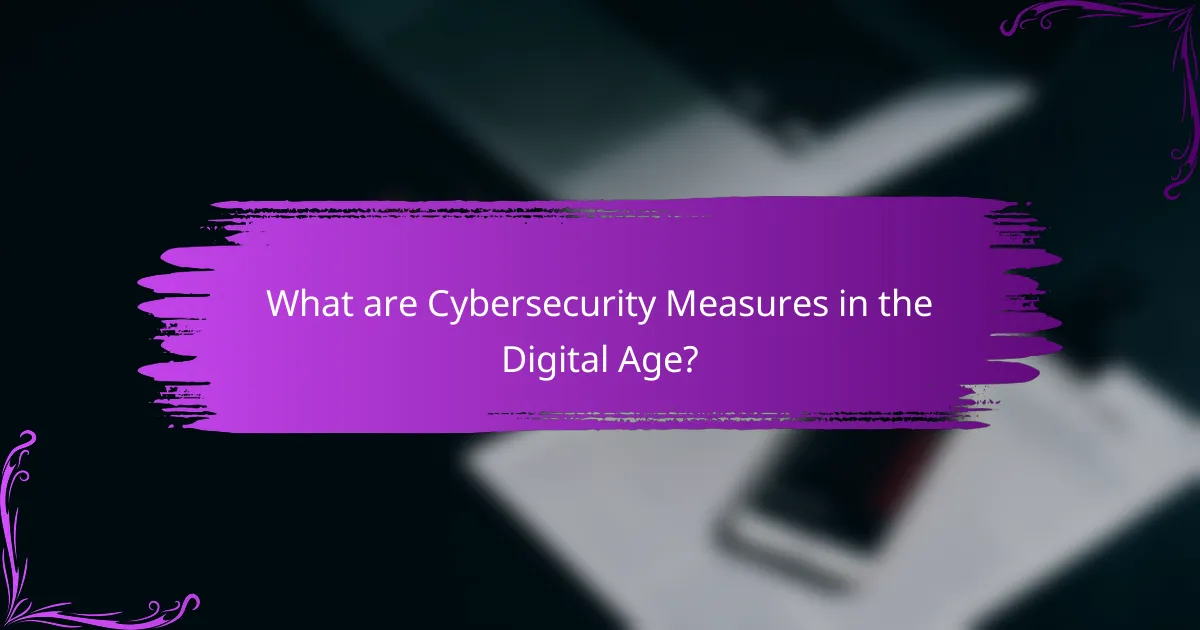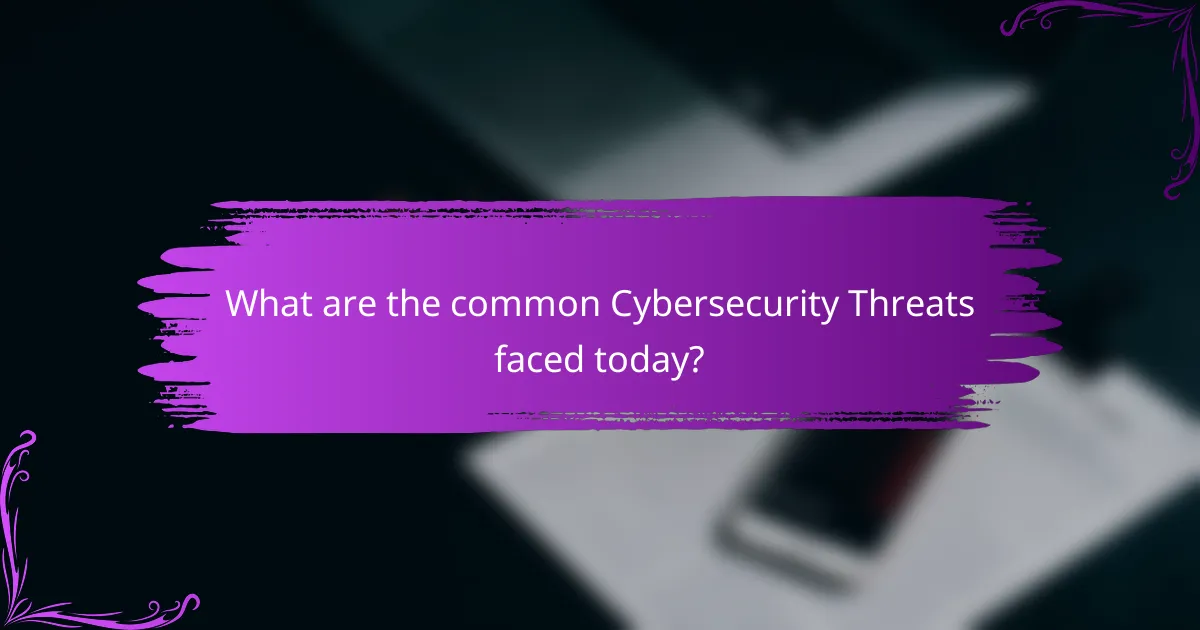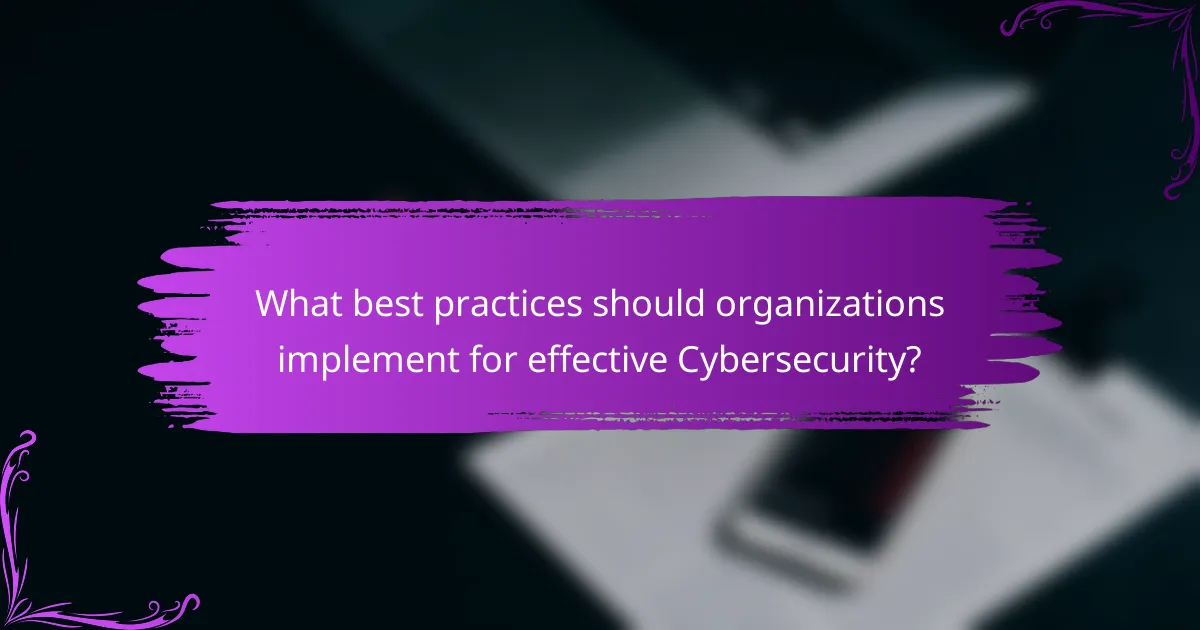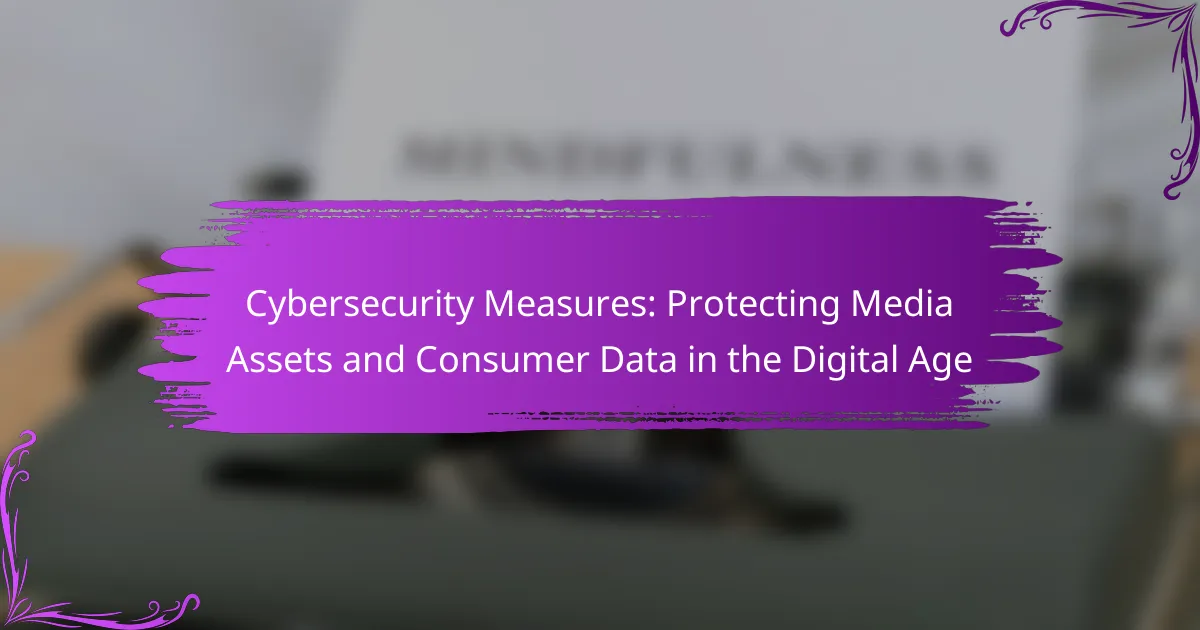
What are Cybersecurity Measures in the Digital Age?
Cybersecurity measures in the digital age are strategies and technologies designed to protect networks, devices, and data from unauthorized access and attacks. These measures include firewalls, antivirus software, and encryption. Firewalls act as barriers between trusted and untrusted networks. Antivirus software detects and removes malicious software from devices. Encryption secures data by converting it into a coded format. Additionally, measures such as multi-factor authentication enhance security by requiring multiple forms of verification. Regular software updates patch vulnerabilities that could be exploited by attackers. Employee training on security best practices helps prevent human error, a common cause of breaches. According to Cybersecurity Ventures, global spending on cybersecurity is expected to exceed $1 trillion from 2017 to 2021, highlighting the growing importance of these measures.
How do Cybersecurity Measures protect Media Assets?
Cybersecurity measures protect media assets by implementing various protocols and technologies. These measures include encryption, which secures data by converting it into a code. Access controls limit who can view or edit media assets. Regular software updates patch vulnerabilities that could be exploited by attackers. Intrusion detection systems monitor network traffic for suspicious activities. Firewalls act as barriers between secure internal networks and external threats. Backup solutions ensure that media assets can be restored in case of data loss. According to a report by Cybersecurity Ventures, cybercrime damages are projected to reach $10.5 trillion annually by 2025, highlighting the importance of robust cybersecurity measures.
What types of Media Assets require protection?
Media assets that require protection include digital content, images, videos, audio files, and software applications. Digital content encompasses any online material that can be accessed or shared. Images and videos often contain proprietary information that can be misused if unprotected. Audio files, such as music or podcasts, also need safeguarding against unauthorized distribution. Software applications represent significant intellectual property and can be vulnerable to piracy or reverse engineering. According to a report by the International Association of Privacy Professionals, the protection of these assets is essential to prevent financial loss and reputational damage.
How do Cybersecurity Measures mitigate risks to Media Assets?
Cybersecurity measures mitigate risks to media assets by implementing protective protocols and technologies. These measures include encryption, which secures data from unauthorized access. They also involve access controls that restrict who can view or modify media assets. Regular software updates help patch vulnerabilities that could be exploited by attackers. Firewalls act as barriers against unauthorized network access, safeguarding media assets from external threats. Additionally, employee training raises awareness about phishing and social engineering attacks. According to a report by the Cybersecurity & Infrastructure Security Agency, organizations that adopt comprehensive cybersecurity strategies reduce the likelihood of data breaches significantly. These strategies collectively enhance the security and integrity of media assets in a digital environment.
Why is Consumer Data Protection crucial in Cybersecurity?
Consumer data protection is crucial in cybersecurity because it safeguards sensitive information from unauthorized access and breaches. Protecting consumer data builds trust between businesses and their customers. According to a 2020 study by IBM, the average cost of a data breach is $3.86 million. Data breaches can lead to severe financial losses and reputational damage. Effective data protection measures reduce the risk of identity theft and fraud. Regulations like GDPR emphasize the importance of consumer data protection. Compliance with such regulations helps organizations avoid hefty fines. Overall, robust consumer data protection is essential for maintaining a secure digital environment.
What types of Consumer Data are at risk?
Personal identification information is a type of consumer data at risk. This includes names, addresses, and Social Security numbers. Financial information is also vulnerable. Credit card numbers and bank account details can be compromised. Health data poses significant risks as well. Medical records and health insurance information are often targeted. Online account credentials are frequently at risk too. Usernames and passwords can be stolen through various cyber attacks. Behavioral data, such as browsing history and purchase patterns, is also at risk. This information can be exploited for targeted advertising or identity theft.
How can Cybersecurity Measures enhance Consumer Data Protection?
Cybersecurity measures enhance consumer data protection by implementing strategies that secure sensitive information. These measures include encryption, which protects data in transit and at rest. Regular software updates and patches fix vulnerabilities that could be exploited by attackers. Firewalls act as barriers against unauthorized access to networks. Multi-factor authentication adds an extra layer of security, ensuring that only authorized users can access data. Employee training on cybersecurity best practices reduces the risk of human error. According to the Cybersecurity & Infrastructure Security Agency, organizations that adopt these measures significantly lower their risk of data breaches. In 2020, companies with robust cybersecurity protocols experienced 60% fewer data breaches than those without such measures.

What are the common Cybersecurity Threats faced today?
Common cybersecurity threats today include malware, phishing, ransomware, and insider threats. Malware refers to malicious software designed to harm or exploit devices. Phishing involves deceptive emails or messages to trick users into revealing sensitive information. Ransomware encrypts files and demands payment for decryption. Insider threats occur when employees misuse access to compromise security. According to the Cybersecurity and Infrastructure Security Agency (CISA), these threats are prevalent and evolving. In 2022, the FBI reported over 19,000 ransomware incidents. These statistics highlight the urgency of addressing these cybersecurity challenges.
How do Cybersecurity Threats impact Media Assets?
Cybersecurity threats significantly impact media assets by compromising their integrity, availability, and confidentiality. Such threats can lead to unauthorized access, resulting in data breaches. Media organizations may suffer financial losses due to operational disruptions. For instance, ransomware attacks can encrypt critical media files, making them inaccessible. According to a 2021 report by Cybersecurity Ventures, global ransomware damages are projected to reach $20 billion. Furthermore, these threats can damage a brand’s reputation, leading to a loss of audience trust. In 2020, 60% of media companies reported experiencing a cyber incident. Overall, cybersecurity threats pose a critical risk to the stability and security of media assets.
What are the most prevalent Cybersecurity Threats to Media Assets?
The most prevalent cybersecurity threats to media assets include ransomware, phishing attacks, and insider threats. Ransomware encrypts media files, demanding payment for decryption. Phishing attacks trick users into revealing sensitive information, often through deceptive emails. Insider threats arise from employees misusing access to media assets, either maliciously or unintentionally. According to the Cybersecurity and Infrastructure Security Agency, ransomware attacks have increased by 150% in recent years. Phishing remains a leading cause of data breaches, accounting for 32% of incidents reported in 2021. Insider threats are responsible for over 30% of data breaches, highlighting the need for robust security measures.
How can organizations identify these Cybersecurity Threats?
Organizations can identify cybersecurity threats through various methods. They can conduct regular security assessments and vulnerability scans. Monitoring network traffic helps detect unusual activity. Implementing threat intelligence solutions provides insights into emerging threats. Employee training raises awareness about phishing and social engineering attacks. Using intrusion detection systems alerts organizations to potential breaches. Analyzing logs from security devices reveals patterns of suspicious behavior. Collaborating with cybersecurity experts enhances threat identification capabilities. These strategies collectively improve an organization’s ability to recognize and respond to cybersecurity threats effectively.
What are the implications of Cybersecurity Threats on Consumer Data?
Cybersecurity threats significantly compromise consumer data, leading to data breaches and identity theft. These threats can result in unauthorized access to sensitive information, including personal and financial details. According to the Identity Theft Resource Center, there were over 1,100 data breaches reported in 2020, affecting millions of consumers. When consumer data is stolen, individuals may face financial loss and damage to their credit scores. Additionally, companies may suffer reputational harm and legal consequences due to inadequate data protection measures. The implications extend to increased consumer distrust in digital platforms, impacting overall online engagement and commerce.
What types of breaches are most harmful to Consumer Data?
Data breaches that expose personal identification information (PII) are most harmful to consumer data. These breaches can lead to identity theft and financial fraud. Examples include hacking incidents that compromise databases containing names, addresses, Social Security numbers, and credit card information. According to the Identity Theft Resource Center, 2021 saw a significant increase in such breaches, with over 1,800 incidents reported. Phishing attacks are another harmful type, tricking consumers into revealing sensitive information. Ransomware attacks can also be damaging, as they encrypt consumer data and demand payment for its release. Each of these breaches has severe implications for consumer trust and financial security.
How can organizations prepare for potential breaches?
Organizations can prepare for potential breaches by implementing comprehensive cybersecurity strategies. This includes conducting regular risk assessments to identify vulnerabilities. They should establish an incident response plan to address breaches effectively. Training employees on security awareness is crucial to prevent human error. Organizations must also ensure that software and systems are regularly updated to protect against known threats. Utilizing encryption for sensitive data can mitigate the impact of a breach. Additionally, organizations should conduct [censured] testing to evaluate their security posture. According to a 2021 report by IBM, organizations with an incident response team reduce the cost of data breaches by an average of $2 million.

What best practices should organizations implement for effective Cybersecurity?
Organizations should implement multi-factor authentication (MFA) as a best practice for effective cybersecurity. MFA adds an additional layer of security beyond just a password. It requires users to provide two or more verification factors to gain access. This significantly reduces the risk of unauthorized access. According to a 2020 report by Microsoft, MFA can block 99.9% of automated attacks.
Regular software updates are essential for maintaining cybersecurity. Keeping systems up to date helps protect against vulnerabilities. Cybercriminals often exploit outdated software to gain access. The Cybersecurity and Infrastructure Security Agency (CISA) emphasizes the importance of timely updates to mitigate risks.
Employee training on cybersecurity awareness is crucial. Organizations should educate their staff about phishing attacks and safe online practices. A study by the Ponemon Institute found that human error is a leading cause of data breaches. Regular training sessions can help reduce this risk.
Implementing a robust incident response plan is also necessary. This plan outlines steps to take in the event of a cybersecurity breach. Having a clear response strategy can minimize damage and recovery time. The National Institute of Standards and Technology (NIST) recommends developing and regularly testing incident response plans.
Finally, organizations should conduct regular security assessments. These assessments identify vulnerabilities within the system. Regular testing helps organizations stay proactive in their cybersecurity efforts. The SANS Institute highlights that continuous monitoring is key to effective cybersecurity.
How can organizations develop a robust Cybersecurity Strategy?
Organizations can develop a robust Cybersecurity Strategy by conducting a thorough risk assessment. This assessment identifies vulnerabilities and potential threats to sensitive data. Next, organizations should implement a layered security approach. This includes firewalls, intrusion detection systems, and encryption. Regular employee training on security best practices is essential. Employees must recognize phishing attempts and other social engineering tactics. Additionally, organizations should establish an incident response plan. This plan outlines steps to take in the event of a security breach. Regularly updating software and systems is crucial to protect against new threats. According to a report by Cybersecurity Ventures, global cybercrime costs are expected to reach $10.5 trillion annually by 2025, underscoring the importance of a strong cybersecurity strategy.
What key components should be included in a Cybersecurity Strategy?
A comprehensive cybersecurity strategy should include risk assessment, incident response plan, employee training, and policy development. Risk assessment identifies vulnerabilities and threats to the organization. An incident response plan outlines steps to take during a security breach. Employee training ensures staff are aware of security protocols and best practices. Policy development establishes guidelines for data protection and compliance with regulations. These components are essential for effectively safeguarding media assets and consumer data in the digital age.
How can organizations assess the effectiveness of their Cybersecurity Measures?
Organizations can assess the effectiveness of their cybersecurity measures through regular audits and [censured] testing. These processes identify vulnerabilities within systems and evaluate the response to simulated attacks. Metrics such as incident response time and the number of detected threats provide measurable indicators of effectiveness. Additionally, organizations can utilize frameworks like NIST Cybersecurity Framework to benchmark their practices. Gathering feedback from employees during training exercises also reveals areas for improvement. The 2021 Cybersecurity Workforce Study by (ISC)² found that 63% of organizations lacked a formal cybersecurity strategy, highlighting the importance of ongoing assessment. Regularly updating policies based on emerging threats ensures continued effectiveness.
What tools and technologies are essential for Cybersecurity?
Essential tools and technologies for cybersecurity include firewalls, antivirus software, and intrusion detection systems. Firewalls monitor and control incoming and outgoing network traffic based on security rules. Antivirus software detects, prevents, and removes malicious software. Intrusion detection systems identify and respond to potential security breaches in real-time.
Additionally, encryption tools protect sensitive data by converting it into a secure format. Security Information and Event Management (SIEM) systems aggregate and analyze security data from across an organization. Multi-factor authentication (MFA) adds an extra layer of security by requiring multiple forms of verification.
These tools are critical for safeguarding media assets and consumer data in the digital age. Their effectiveness is supported by industry standards and compliance regulations that mandate their use.
What are the best tools for protecting Media Assets?
The best tools for protecting media assets include Digital Rights Management (DRM) software, watermarking tools, and encryption solutions. DRM software restricts unauthorized access and distribution of digital content. Watermarking tools embed identifiable information into media files, deterring unauthorized use. Encryption solutions protect files by converting them into unreadable formats for unauthorized users. These tools collectively enhance security for media assets. According to a 2021 report by MarketsandMarkets, the global DRM market is projected to grow significantly, indicating its effectiveness in protecting digital content.
How can organizations utilize technology to safeguard Consumer Data?
Organizations can utilize technology to safeguard consumer data through various cybersecurity measures. Implementing encryption protects data during transmission and storage. Firewalls act as barriers against unauthorized access to networks. Regular software updates help patch vulnerabilities that could be exploited by attackers. Multi-factor authentication adds an extra layer of security for user accounts. Data loss prevention tools monitor and protect sensitive information from unauthorized sharing. Additionally, employing intrusion detection systems allows organizations to identify and respond to potential threats in real time. According to a 2021 report by IBM, organizations that implement these technologies can reduce the average cost of a data breach by approximately $1.76 million.
What practical steps can organizations take to enhance Cybersecurity?
Organizations can enhance cybersecurity by implementing a multi-layered security strategy. This includes conducting regular security assessments to identify vulnerabilities. Employee training on phishing and social engineering is essential. Implementing strong password policies and multi-factor authentication significantly reduces unauthorized access. Regular software updates and patch management are crucial for closing security gaps. Utilizing firewalls and intrusion detection systems helps monitor and block malicious activities. Data encryption protects sensitive information during transmission and storage. Lastly, developing an incident response plan ensures quick recovery from cyber incidents. These steps collectively strengthen an organization’s cybersecurity posture.
How can organizations continuously improve their Cybersecurity Measures?
Organizations can continuously improve their cybersecurity measures by implementing regular security assessments. These assessments identify vulnerabilities in systems and processes. Organizations should conduct [censured] testing to simulate cyber-attacks. This helps in understanding potential weaknesses.
Training employees on cybersecurity best practices is crucial. Research shows that human error contributes to 95% of cybersecurity breaches. Regular training sessions can significantly reduce this risk.
Updating software and systems frequently is essential. Cyber threats evolve rapidly, and outdated software can expose organizations to risks. Implementing a patch management process ensures vulnerabilities are addressed promptly.
Utilizing advanced security technologies enhances protection. Tools like intrusion detection systems and firewalls provide additional layers of security. Organizations should also consider adopting artificial intelligence for threat detection.
Establishing an incident response plan is vital. This plan outlines steps to take during a security breach. Organizations with a response plan can mitigate damage more effectively.
Lastly, engaging with cybersecurity professionals for audits can provide external insights. These experts can offer recommendations tailored to the organization’s specific needs. Regularly reviewing and updating cybersecurity policies is also necessary to adapt to new threats.
Cybersecurity measures are essential strategies and technologies aimed at protecting media assets and consumer data from unauthorized access and cyber threats in the digital age. This article outlines various cybersecurity protocols, including firewalls, encryption, and multi-factor authentication, that safeguard digital content, images, videos, and sensitive consumer information. It also highlights the importance of employee training, regular software updates, and incident response plans in mitigating risks associated with common threats such as malware, phishing, and ransomware. Additionally, the article discusses the implications of data breaches on consumer trust and financial security, emphasizing the need for robust cybersecurity strategies to effectively protect valuable assets.



